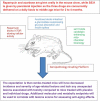Testing drug combinations to slow aging
- PMID: 29291036
- PMCID: PMC5706479
- DOI: 10.1080/20010001.2017.1407203
Testing drug combinations to slow aging
Conflict of interest statement
No potential conflict of interest was reported by the authors.
Figures

Similar articles
-
Pairwise combinations of chemical compounds that delay yeast chronological aging through different signaling pathways display synergistic effects on the extent of aging delay.Oncotarget. 2019 Jan 8;10(3):313-338. doi: 10.18632/oncotarget.26553. eCollection 2019 Jan 8. Oncotarget. 2019. PMID: 30719227 Free PMC article.
-
An Incipient Revolution in the Testing of Anti-aging Strategies.Biochemistry (Mosc). 2018 Dec;83(12):1517-1523. doi: 10.1134/S000629791812009X. Biochemistry (Mosc). 2018. PMID: 30878026 Review.
-
Drug Synergy Slows Aging and Improves Healthspan through IGF and SREBP Lipid Signaling.Dev Cell. 2018 Oct 8;47(1):67-79.e5. doi: 10.1016/j.devcel.2018.09.001. Epub 2018 Sep 27. Dev Cell. 2018. PMID: 30269951
-
A New Preclinical Paradigm for Testing Anti-Aging Therapeutics.J Gerontol A Biol Sci Med Sci. 2017 Jun 1;72(6):760-762. doi: 10.1093/gerona/glx019. J Gerontol A Biol Sci Med Sci. 2017. PMID: 28329081 Free PMC article.
-
Biophysical alterations of hippocampal pyramidal neurons in learning, ageing and Alzheimer's disease.Ageing Res Rev. 2004 Nov;3(4):383-406. doi: 10.1016/j.arr.2004.07.001. Ageing Res Rev. 2004. PMID: 15541708 Review.
Cited by
-
Pairwise combinations of chemical compounds that delay yeast chronological aging through different signaling pathways display synergistic effects on the extent of aging delay.Oncotarget. 2019 Jan 8;10(3):313-338. doi: 10.18632/oncotarget.26553. eCollection 2019 Jan 8. Oncotarget. 2019. PMID: 30719227 Free PMC article.
-
A Geroscience Approach to Preventing Pathologic Consequences of COVID-19.J Interferon Cytokine Res. 2020 Sep;40(9):433-437. doi: 10.1089/jir.2020.29018.dou. Epub 2020 Aug 13. J Interferon Cytokine Res. 2020. PMID: 32790488 Free PMC article.
-
Pharmaceutical interventions to slow human aging. Are we ready for cocktails?Aging Pathobiol Ther. 2022;4(2):51-52. doi: 10.31491/apt.2022.06.086. Epub 2022 Jun 30. Aging Pathobiol Ther. 2022. PMID: 36082207 Free PMC article.
-
Short term treatment with a cocktail of rapamycin, acarbose and phenylbutyrate delays aging phenotypes in mice.Sci Rep. 2022 May 4;12(1):7300. doi: 10.1038/s41598-022-11229-1. Sci Rep. 2022. PMID: 35508491 Free PMC article.
References
Publication types
LinkOut - more resources
Full Text Sources
Other Literature Sources
